
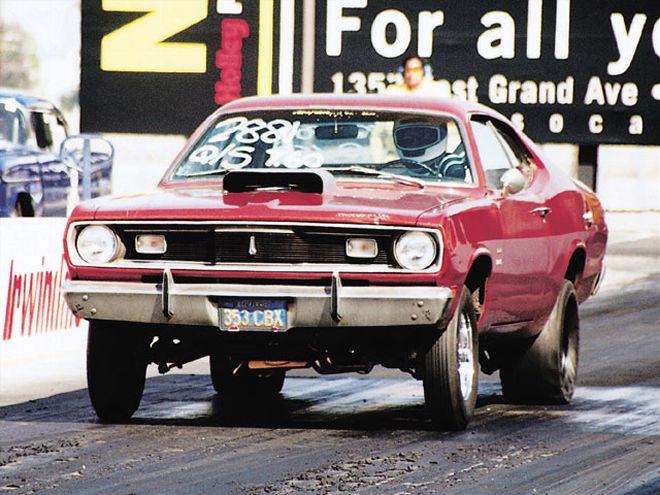
Plunging below the 3,000-pound weight barrier has always been a challenging yet critical goal for those wanting quicker e.t's at the strip. But thanks to the wide variety of lightweight aftermarket goodies available today, shedding pounds is easier than ever, regardless of vehicle make. From Mustangs to GTOs to Malibus to Mopars, you can take your pick from aluminum heads, fiberglass body panels, lightweight brakes, tubular control arms and frame stubs, Lexan windows, plastic springs, aluminum rearend parts, and other goodies that bolt right on. Open your wallet wide and you'll see that it's possible to shed as much as 600 pounds without ever touching a torch or holesaw. It has never been so easy to lose weight and go fast.
While the performance industry has often used the gauge of power-to-weight ratio, we decided to look at weight-to-power (W/P) ratio instead, since it's the pounds we're improving as power remains the constant. We find the W/P ratio by simply dividing total vehicle weight by horsepower. Consider this: a 3,000-pound car packing 450 hp requires each horsepower to carry 6.66 pounds--the exact same ratio as a 4,000-pound car with 600 hp or a 2,000-pound car with a mere 300 hp. Work the numbers backward and it becomes clear that shedding pounds is just like adding horsepower.
To explore the effect, we took a cost-is-no-object stance to shed a total of 588 pounds from our 408hp '70 Plymouth Duster. Sharp readers will note the lack of an aluminum radiator, light battery, and aluminum master cylinder. We had planned for these goodies but magazine deadline realities prevented their inclusion. Despite this, we managed to drop total vehicle weight (less driver) from 3,012 pounds to a shocking 2,424 pounds. Best of all, eighth-mile dragstrip performance improved from 7.627 seconds and 89.38 mph to 7.235/93.95. For approximate quarter-mile numbers, take those e.t.'s and multiply by 1.57. This shows a drop from 11.93 seconds to 11.35 seconds (5.8 tenths) and proves, almost to perfection, the drag racer's assumption that 100 pounds lost equals a tenth gained in the quarter. Also, we used our Longacre scales to reveal not only the total weight loss, but also how it affected the car's weight distribution.
Though the over-$10G total cost of our lightweight bolt-ons may seem like a bad case of leaky bucket economics, we counter with the fact that a typical 2,400-pound, tubs-'n'-tubes race car would cost plenty more to construct. To help you decide which parts make sense to your budget, we've included the dollar cost per pound removed (C/PR) quotient for each item. In some cases, you might need CPR when the price is revealed. But as the man said, speed costs money son, how fast ya wanna go?
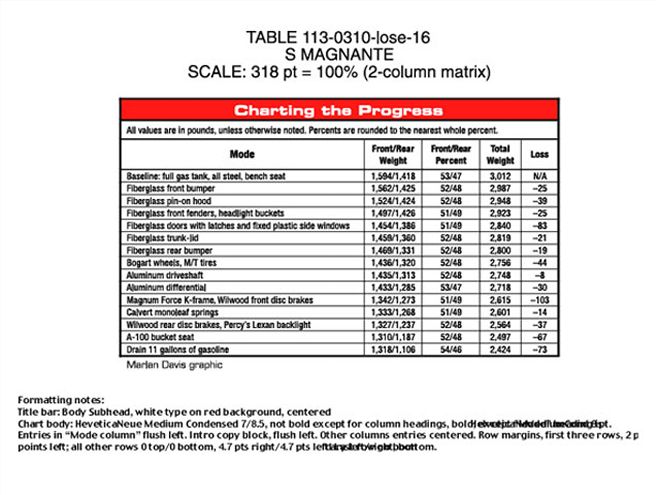
"The acceleration of an object is directly proportional to the net force acting upon it and is inversely proportional to its mass..."
--Newton's Second Law of Motion
Did You Know ...?
Weight is the measure of the earth's gravitational pull on an object. Mass is a measure of the amount of matter in an object. Put our Duster on the moon and its weight changes; its mass does not. Inertia is a measure of an object's resistance to a change in direction or acceleration; mass affects inertia, weight does not, though the distinction matters little when drag racing on this planet. However, the more mass, the more inertia--and the more inertia, the more the resistance to acceleration.
--David Freiburger
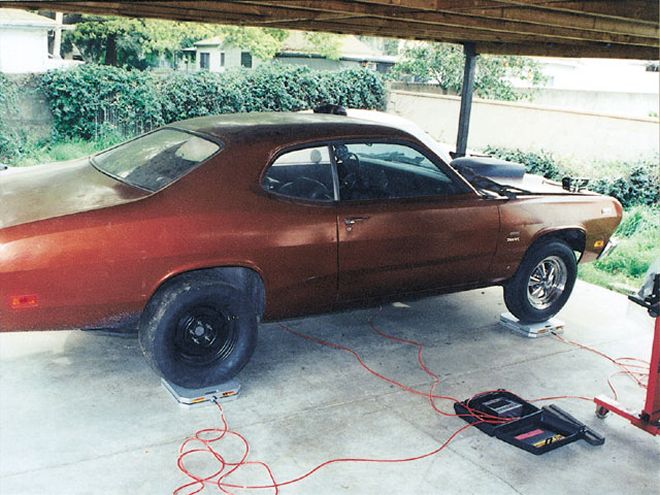
Step 1
Baseline
Total: 3,012 pounds
W/P ratio: 7.38:1
Though our test car's heater, headliner, carpet, rear seat, and cardboard interior panels had long since vanished, it still tipped the scales at 3,012 with a full tank (16 gallons). For this story, we filled the tank before any modifications so all scale numbers except the last set (when we intentionally removed gas) are recorded with 112 pounds of gasoline on board.
Motivation comes from a mild 360 that's based on a Mopar Performance 10.0:1 short-block (P4876908), untouched Edelbrock Performer aluminum heads (PN 6077), Torker II intake (PN 5076), 750-cfm Performer carburetor (PN 1407), and an Isky 280-Mega hydraulic flat-tappet cam (232/232 duration at 0.050, 0.485/0.485 gross lift, 108-degree LSA). See our April 2001 issue ("Small-Block Shuffle") for the complete recipe as well as dyno results showing that it makes 408 hp at 5,600 rpm and 406 lb-ft of torque at 4,900.
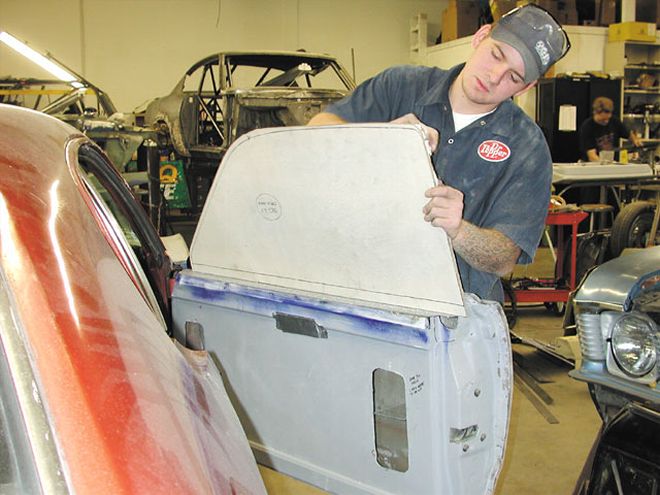
The small-block feeds power to a 10-inch TCI Super Street Fighter 3,500-stall converter (PN 142222), TCI full-manual 727 Torqueflite (PN 112700) and 3.91:1-geared Chrysler 83/4 rearend with an MP '68 Hemi A-Body leaf spring inboard relocation kit for ¾ inch of extra tire sidewall clearance (PN P4120077 front hangars, P4120075 rear shackles). Hooker 1 5/8-inch-primary Super Comp headers (PN 5116-1) and dual 2 ½-inch DynoMax Super Turbo mufflers handle the exhaust.
Step 2
Fiberglass Body Panels
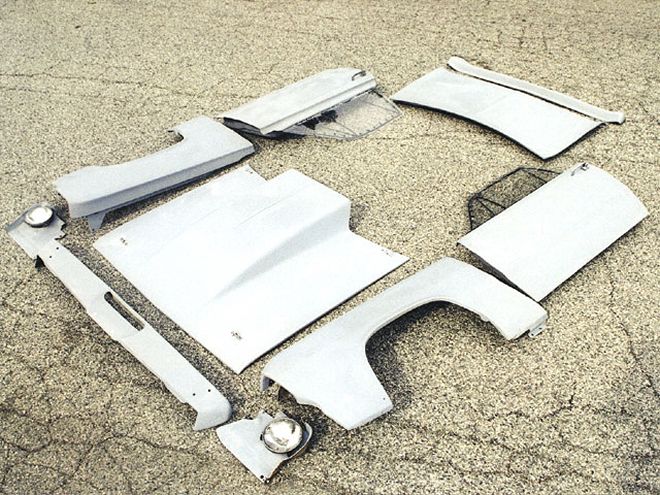
Weight Loss: 212 pounds
New Total: 2,800 pounds
W/P Ratio: 6.86
C/PR: $8.47
The main disadvantage of a front-engine, rear-drive drag racing chassis is that the drivetrain location places more weight on the front tires than the drive tires. Replacing the hefty steel body panels and bumpers with fiberglass replicas is an excellent remedy. We raided the Unlimited Performance fiberglass catalog and treated the Duster to a front bumper (PN PL710, $99.95), 8-inch pin-on cowl hood (PN PL786, $399), front fenders (PN PL305 R/L, $149 each), headlight buckets (PN PL306 R/L, $30 each), doors (PN PL712 R/L, $149 each), trunklid (PN PL703H, $139.95), and rear bumper (PN PL711, $99.95). Finally, we paid Adrian Chavira of PMR Racecars $400 to install plexi side windows and door latches. The total cost of the fiberglass transformation is $1,794.85 ($1,394.85 plus $400 labor), saving us 212 pounds. To monitor the step-by-step impact of the fiberglass transformation on the car's weight bias and to see how these parts might work on your ride, check out the accompanying chart (page 83).
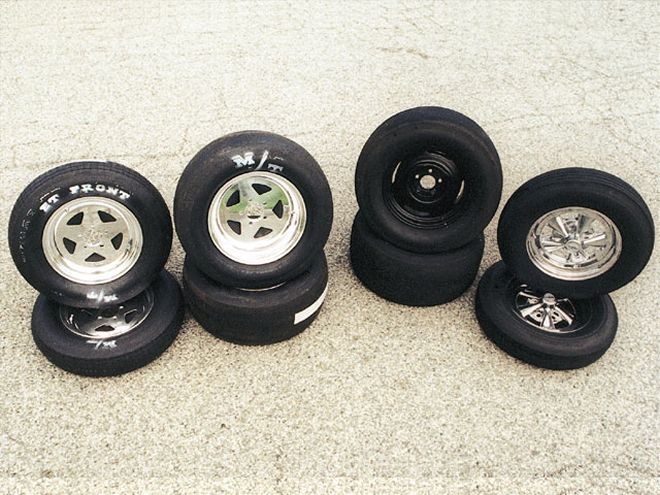
Step 3
Bogart Wheels, M/T Tires
Weight Loss: 44 pounds
New Total: 2,756 pounds
W/P ratio: 6.75
C/PR: $31.84
Though the Duster had a neat retro look with the 15x4 ½ Cragar S/S wheels with repop Coker 6.40-15 skins up front and 15x7 Chrysler steelies and slicks out back, the pairings weigh 36 pounds each (front) and 39 pounds each (rear). By reducing rotating mass, less power is required to set things in motion, so we specified Bogart Classic Star rims (15x3.5, $163 each/15x8, $252 each) and M/T 27.5x4.50-15 ET Front (PN 3909, $125.95 each) and M/T 26x10.00-15 ET Drag slicks (PN 3053, $159.95 each). The new wheel/tire combos weigh 21 pounds each (front) and 32 pounds (rear) for a total reduction of 44 pounds. As the photos prove, Bogarts have a magical way of making even the raunchiest car look great. And the M/T slicks have what it takes to generate consistent 1.574 60-foot times. The total cost was $1,401.09.
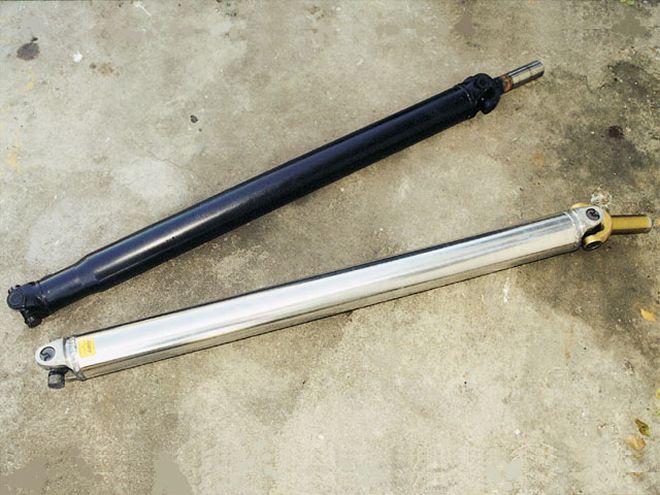
Step 4
Aluminum Driveshaft
Weight Loss: 8 pounds
New Total: 2,748 pounds
W/P Ratio: 6.74
C/PR: $41.88
Going further on the quest to reduce rotating weight as well as overall weight, we pitched the stock 19-pound, 3 ¼-inch steel driveshaft in favor of a Victory Performance 3 ½-inch aluminum 'shaft from Randy's Ring & Pinion. It measures 45½ inches center-to-center and fits our Duster's 108-inch wheelbase perfectly. The Victory 'shaft afforded us the benefit of GMC truck-sized 1350 U-joints, plus it cut weight by 8 pounds for $335. Though the trick Victory driveshaft is overkill in this fairly mild application, it's great to know it'll be up to whatever mill we drop in this thing next.
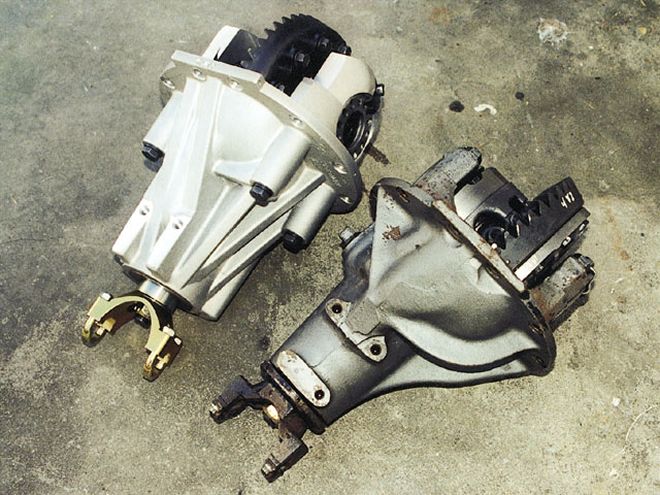
Step 5
Aluminum Differential
Weight Loss: 30 pounds
New Total: 2,718 pounds
W/P Ratio: 6.66
C/PR: $51.85
When Mopar Performance introduced its aluminum 8 ¾ differential carrier (PN 4876445) a few years back, it ensured a bright future for the popular Chrysler axle design. Randy's Ring & Pinion set us up with one that's got 3.91:1 gears, a 1350 yoke, and a 30-spline spool. At 53 pounds it's exactly 30 percent lighter than the previous cast-iron, 742-case, 3.91:1 Sure Grip, slashing a full 30 pounds of unsprung weight. Many chassis engineers say that if high-speed maneuvering or road racing is in the cards, removing one pound of unsprung weight is equal to three pounds of sprung weight. Though our straight-line Duster won't go autocrossing anytime soon, we'll take the 30 pounds. At $1,555.55 it's priced in line with similar offerings for the Ford 9-inch, but unlike Ford-based designs, has a provision for a pinion snubber.
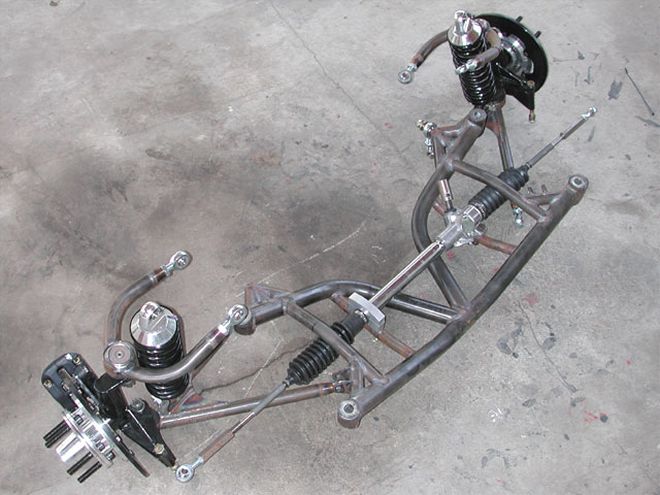
Step 6
Tubular K-Frame, Front Disc Brakes
Weight Loss: 103 pounds
New Total: 2,615 pounds
W/P Ratio: 6.41
C/PR: $36.51
Magnum Force Race Car Fabrication took a look at the stock Chrysler K-frame, torsion bar suspension, and brake situation and came up with a low-mass replacement. It uses Aldan coilover springs in place of the torsion bars, a Flaming River steering rack instead of the bulky steering box and linkage, and 100 percent fat-free Wilwood disc brakes. Finally, the hefty stamped steel K-member and upper and lower control arms are replaced by components crafted from lightweight chrome-moly tubing. For a complete report on installation particulars and do-it-yourself small-block motor mounts, check out hotrod.com/techarticles/chassis/113_0309_kfra.
Small-block users will need to switch to a rear-sump oil pan for proper clearance. We used an 8-quart Milodon pan (PN 30985, $228.95) and matching pickup (PN 18460, $36.95). The complete Magnum Force tubular K-frame kit with brakes, rack, and coilovers comes to $3,495 plus $265.90 for the required Milodon goodies. For a 103-pound weight drop, $3,760.90 may seem like a pile o' dough. But this stuff has its place as proven by the fact that plenty of hard-hitting 8-second Mopar drag cars use it. We like the instant steering response, improved braking, and incredible header clearance.
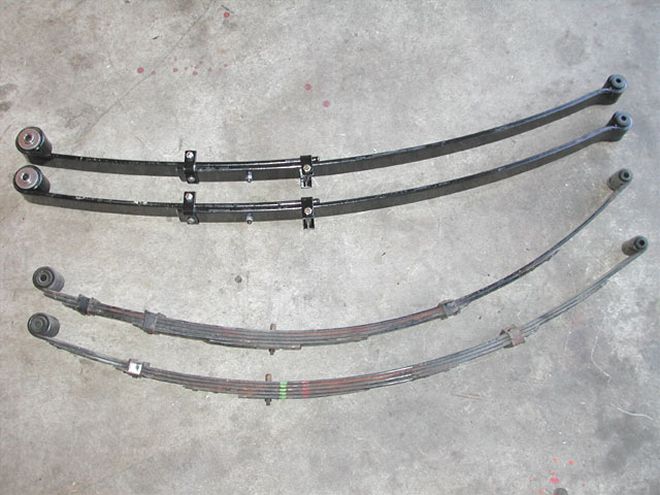
Step 7
Monoleaf Springs
Weight Loss: 14 pounds
New Total: 2,601 pounds
W/P Ratio: 6.38
C/PR: $21.86
Our former Mopar Performance Super Stock leaf springs worked, but they're pretty heavy so we got a set of Cal-Tracs two-piece monoleaf steel springs (PN LF120-345). At 25 pounds each they're a total of 14 pounds lighter. But as John Calvert warned us, they are designed to work with his Cal-Tracs adjustable traction links. We wanted to see if we could skimp to save pounds by substituting a simple (and lighter) MP adjustable pinion snubber (PN P5007483 for the MP aluminum 8 ¾ differential). The combination didn't exhibit any axle hop. Rather, it rippled the M/T 26x10.00-15s (at 10 psi) and yielded consistent 1.57-second 60-foot times. Later, with a 100-horse nitrous hit, wicked 1.438 short times resulted. John Calvert wants us to warn you that your particular combo may require the full Cal-Tracs system for optimum results. At $258 for the springs plus $48 for the snubber, the C/PR works out to $21.85.
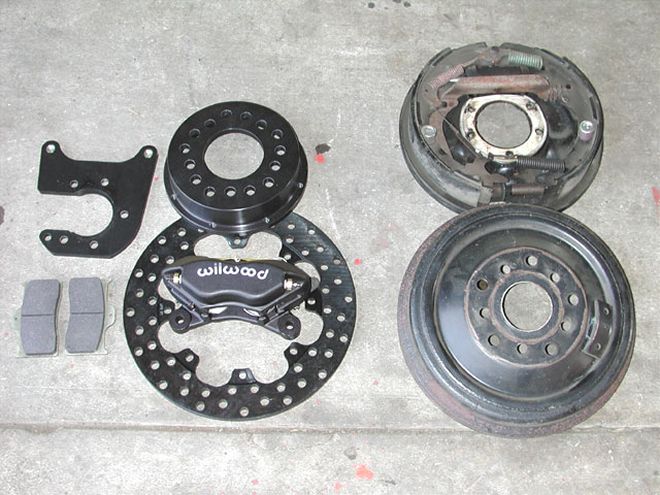
Step 8
Rear Disc Brakes, Backlight
Weight Loss: 37 pounds
New Total: 2,564 pounds
W/P Ratio: 6.28
C/PR: $29.59
With 70 percent of the Duster's deceleration handled capably by the 10.75-inch Magnum Force/Wilwood solid-disc front brakes, the Duster's stock 10x1.75 rear drums become little more than dead weight--24 pounds per side to be precise. In their place, a Wilwood rear drag brake kit (PN 140-0260-BD) got the nod. At 11 pounds per side, the drilled 11.44-inch rotors and four-piston billet aluminum calipers increase braking capacity, allow easy power braking in the bleach box, and trim 26 pounds of unsprung weight for a $488.73 investment.
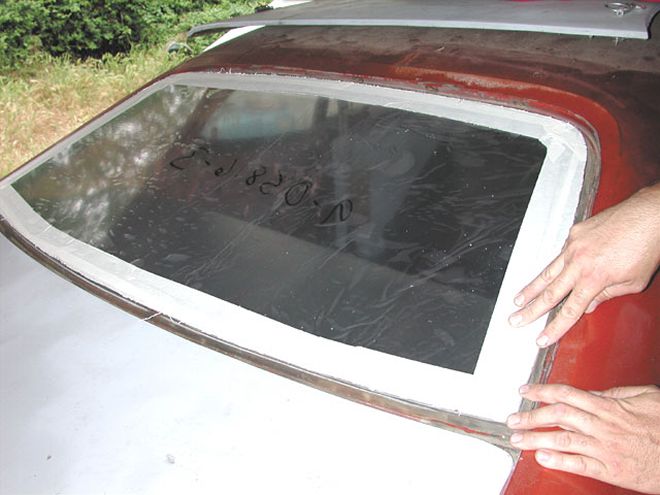
Be advised, stock A-Body 8 ¾ axleshafts have a 1.75-inch axle-flange offset (distance from the end of the housing to the face of the wheel flange). The Wilwood discs are designed for use with the 2.36-inch offset used on more common Chrysler B-, C-, and E-Body axles, so we got a set of hybrid 30-spline Yukon alloy axles from Randy's Ring & Pinion with A-Body length (28 inches) and the required B-Body bearing offset (PN YAC8.75-28.0). The axles cost $205.98 complete with convenient non-adjustable Green axle bearings. Combined with the cost of the Wilwood rear discs, the total comes to $694.71 and has a C/PR of $26.71.
The rear window is another target of opportunity in the war against flab. The stock glass weighs 19 pounds, so an 8-pound Speedglass replica (PN 05816-3) from Percy's High Performance was substituted. The $400 Speedglass backlight is made of GE Lexan with a proprietary coating applied to both sides resulting in a thin shell that is virtually as hard as glass. We are impressed by the amazing optical clarity and may be tempted later to replace the Duster's stock glass front windshield as our experience with Speedglass has us convinced the windshield wipers are unlikely to do harm. With an 11-pound savings, the Percy's backlight has a C/PR of $36.36.
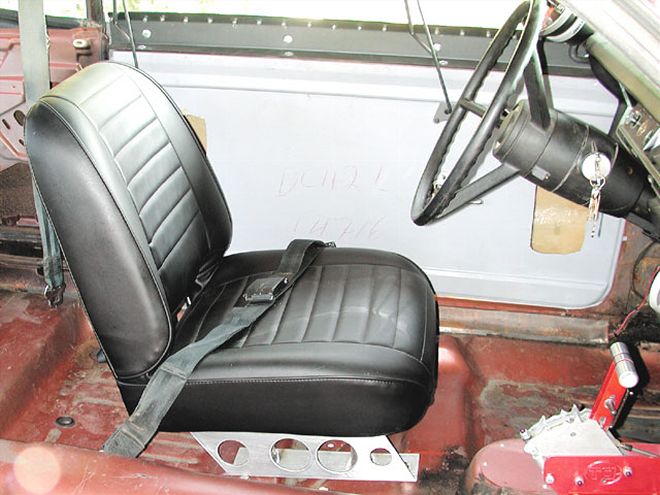
Step 9
Bucket Seat
Weight Loss: 67 pounds
New Total: 2,497 pounds
W/P Ratio: 6.12
C/PR: $4.78
The stock split-bench seat is a 95-pound monster. In its place we went with a rebuilt Dodge A-100 van seat mounted on repop '68 Hemi Dart aluminum seat brackets from Kramer Automotive Specialties. The 28-pound seat cost $20 at the local Pick-A-Part, a local upholstery shop charged $150 to re-foam and recover it with the original pleated pattern, and we paid Kramer $150 for the aluminum seat brackets. The total comes to $320 with a refreshingly low C/PR of $4.78. Imagine the C/PR of a $39.99 fiberglass bucket seat from Summit!
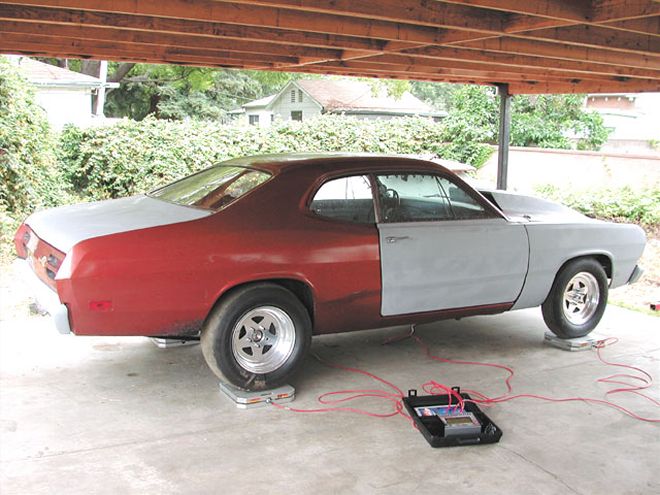
Step 10
Drain Gas Tank
Weight Loss: 73 pounds
New Total: 2,424 pounds
W/P Ratio: 5.94
C/PR: Free!
Remember that full tank of gas we started with? Let's pump out 11 gallons and shed 73 pounds in the process. That leaves us with a safe minimum of 5 gallons in the Duster's stock 16-gallon gut and a final vehicle weight of 2,424 pounds. Interestingly, as the accompanying weight distribution chart reveals, the front/rear weight bias is at its worst point now, with the front tires carrying 212 pounds more than the rear tires. Long gone is the near 50/50 split we flirted with on our path to ballistic bliss. But there's a world of difference between static and dynamic load distribution and the excellent 1.57 60-foot times attest to the fact that the greater benefit of reduced overall weight has prevailed.
Weight Here
Our test wouldn't have been possible without the help of the Accuset four-wheel scale system from Longacre Racing Products. Ours is the entry level model (PN 72594) that retails for about $1,200, reads corner weight, crossweight, and front/rear bias, and is accurate to within a fraction of a pound. If the wind blows, these scales show it. When our buddies found out we had this thing, we had a nonstop scale session and debunked plenty of pipe dreams with accurate weight data. An enterprising type could probably charge ten bucks per car and provide a much-needed service to local racers. In this setting, the unit could quickly pay for itself.